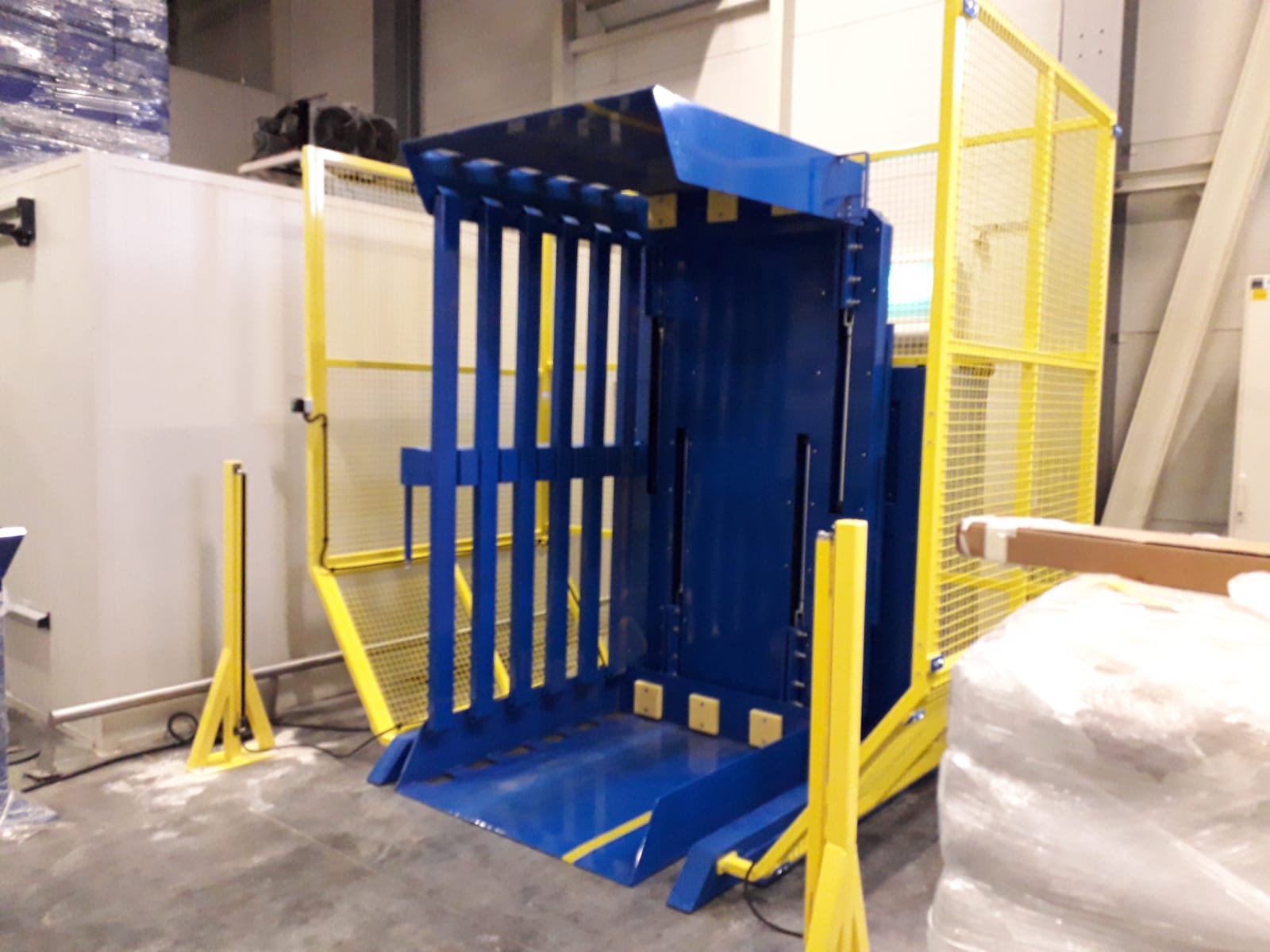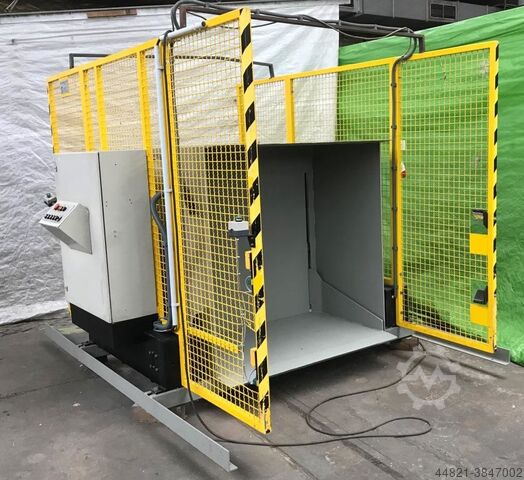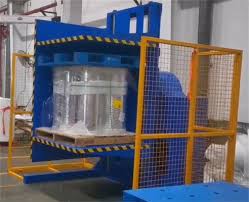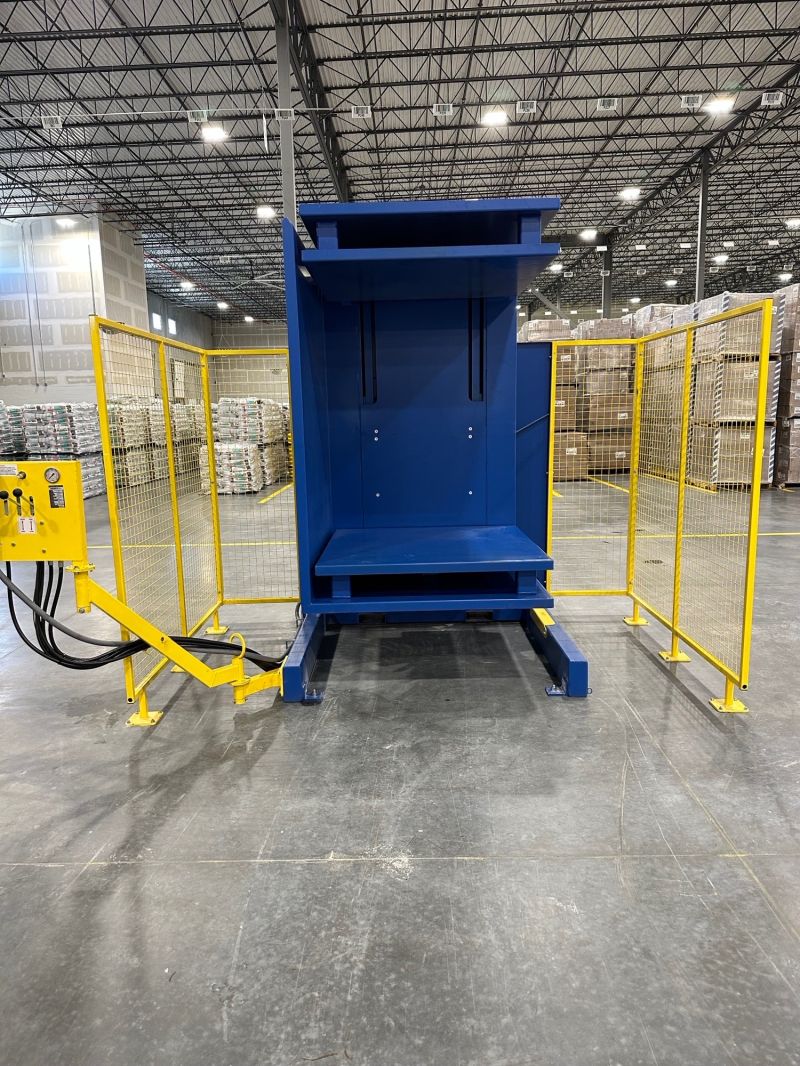[Engineer's Guide] How to Choose the Right Mold Flipper for Your Workshop?
Flipping a multi-ton mold with a crane is a slow, risky process. I’ve seen it many times in workshops across the world. An unstable lift can damage a mold that costs tens of thousands of dollars. Worse, it puts your team in danger. This manual process creates a serious bottleneck in your workflow, delaying production and maintenance schedules. The constant worry about safety and efficiency is a heavy burden for any factory owner. You need a better, safer, and more reliable method, but investing in a large piece of equipment comes with its own set of questions.
Choosing the right mold flipper requires a clear evaluation of your specific needs. The best choice depends on four key factors: the weight and dimensions of your molds, the required turning angle for your processes (either 90 or 180 degrees), the critical safety features you need, and how the machine will integrate into your existing workshop layout and future automation plans. A careful analysis of these points ensures you invest in a solution that boosts both safety and productivity.
![[Engineer’s Guide] How to Choose the Right Mold Flipper for Your Workshop? [Engineer’s Guide] How to Choose the Right Mold Flipper for Your Workshop?](https://res.cloudinary.com/dheixzr6f/image/upload/v1741318561/pallet_inverter_for_supply_chain_optimization_n0foza.jpg)
This guide is based on my journey from a young engineer to a factory owner. I've faced these same decisions. I made some mistakes and learned valuable lessons. Now, I want to share my experience to help you make the right choice from the start. We will break down each critical factor step-by-step. This will help you select a mold flipper that not only solves your immediate problems but also supports your long-term goals for growth and efficiency.
What are the primary types of mold flippers?
You look at the market and see many machines. They are all called mold flippers or mold inverters, but they look and function differently. It can be confusing. If you choose the wrong type, you might spend a lot of capital on a machine that doesn't actually fit your process. This is a costly mistake that slows down your operations instead of speeding them up. The solution is to first understand the fundamental differences between the main types of equipment available.
The two primary types of mold flippers are 90-degree tilters and 180-degree inverters. The 90-degree tilter is designed to turn a mold on its side, making it ideal for inspections, cleaning, and light maintenance. The 180-degree inverter performs a complete turnover, which is essential for more complex tasks like separating mold halves or performing major repairs and assembly.

Let's dive deeper into these two types. Your choice here will define how your team interacts with your molds for years to come. I remember a client in the steel industry who was focused on saving initial costs. He bought a 90-degree tilter because it was cheaper. His goal was to perform maintenance on large casting molds. He soon realized that his maintenance process required complete access to the bottom of the mold and sometimes even separating the two halves. The 90-degree tilter could only provide access to one side. His team still had to use an overhead crane for a second, dangerous lift to finish the job. The machine he bought to improve safety and efficiency only did half the job. He eventually had to purchase a 180-degree machine two years later. This is a classic example of how a small initial saving can lead to bigger costs and inefficiencies down the road. Understanding the application is everything.
90-Degree Mold Flipper (Tilter)
A 90-degree mold flipper, often called a tilter, is a relatively simple machine. It typically uses hydraulic cylinders or a mechanical gear system to tilt a load from a horizontal to a vertical position, or vice versa. Its main purpose is to provide quick and safe access to the side or bottom of a die or mold. This is perfect for tasks that don't require the mold to be completely upside down.
Common applications include:
- Inspection: Quickly tilting a mold to check for wear or cracks on its sides.
- Cleaning: Safely positioning a mold to remove debris after a production run.
- Minor Repairs: Accessing specific components on the side of a mold without a full disassembly.
The main advantage of a 90-degree tilter is its efficiency for specific tasks. It often has a faster cycle time than a 180-degree machine. It also tends to have a smaller footprint, which is a big benefit in a crowded workshop. And, as my client learned, it usually has a lower initial purchase price.
180-Degree Mold Flipper (Inverter)
A 180-degree mold flipper, or inverter, is a more complex and versatile machine. It is designed to take a mold and turn it completely upside down. This is usually accomplished with either a strong hydraulic system or a robust electro-mechanical drive using chains or gears. The key function is to allow for complete mold separation (opening the mold) or to provide full access to the bottom half for heavy maintenance.
Common applications include:
- Mold Splitting: Safely opening a mold by turning one half 180 degrees away from the other.
- Heavy Maintenance: Performing significant repairs or modifications on the core or cavity.
- Die Changes: Completely turning a die set over as part of the production changeover process.
The benefits are clear for heavy-duty work. It offers the highest level of safety and access for complex jobs. It eliminates the need for any secondary lifting or turning with a crane. However, these machines are larger, require more floor space, and represent a higher capital investment.
| Feature | 90-Degree Flipper (Tilter) | 180-Degree Flipper (Inverter) |
|---|---|---|
| Primary Use | Inspection, Cleaning, Side Access | Splitting, Assembly, Full Turnover |
| Rotation Angle | 90 Degrees | 180 Degrees |
| Footprint | Smaller | Larger |
| Cost | Lower | Higher |
| Complexity | Simpler Mechanism | More Complex and Robust |
| Ideal For | Quick tasks, workshops with limited space | Heavy maintenance, full mold separation |
How do safety features impact your choice?
The thought of a multi-ton mold slipping or falling is a nightmare for any engineer or manager. It’s not just about the cost of a damaged mold. An accident could cause catastrophic damage to other equipment, lead to a severe injury, or even a fatality. The resulting operational shutdown, investigations, and loss of morale can cripple a business. You cannot afford to compromise on safety. So, when you look at a mold flipper, the safety features are not just optional extras. They are a fundamental requirement for protecting your people and your investment.
When choosing a mold flipper, you must prioritize machines with comprehensive safety systems. Look for robust mechanical locking mechanisms, multiple emergency stop buttons, electrical overload protection, and physical guarding like safety fences or light curtains. These features are essential to prevent accidents, protect your staff, ensure regulatory compliance, and provide the operational stability your plant needs.

Let’s break down what these safety features really mean in practice. It's easy for a sales brochure to list features, but as an engineer, I need to know how they work. I once visited a steel plant where an old piece of equipment was still in use. It was a very basic flipper with no modern safety interlocks. An operator, trying to speed things up, approached the machine while it was still in motion. His glove got caught. Luckily, another worker hit the main power disconnect just in time, and the man was not seriously hurt. But it was a very close call. That incident prompted the plant owner to immediately invest in a new machine with full safety guarding and light curtains. The lesson is clear: investing in safety proactively is always cheaper than reacting to a disaster. This is especially true when dealing with aging equipment that no longer meets modern standards.
Mechanical and Structural Safety
This is the foundation. The machine must be physically strong enough to handle the forces involved.
- Steel Quality and Welds: The machine's frame must be made from high-quality, certified steel. I always ask for material certificates. All welds should be professional, clean, and inspected. A poor weld is a hidden point of failure.
- Mechanical Locking: During a power failure, what holds the load? A good system will have automatic mechanical locks, like heavy-duty pins or clamps, that engage if hydraulic or electrical power is lost. This prevents the mold from crashing down.
- Overload Protection: The system should have a mechanism to prevent it from trying to lift a load that is too heavy. For hydraulic systems, this is a pressure relief valve. For electric systems, it's a motor overload sensor that cuts power.
Electrical and Control Safety
The brain of the machine must be designed for safety.
- Emergency Stops (E-Stops): These must be prominent, easy to reach from all sides of the machine, and hard-wired to immediately stop all motion. They should not be simple software commands.
- Interlock Systems: This is critical. The machine should not operate if a safety gate is open. A light curtain, which creates an invisible barrier of light, should stop the machine instantly if a person or object crosses it. This prevents operators from entering a dangerous area during operation.
- Limit Switches: These physical switches prevent the machine from over-rotating or moving beyond its designed range, which could cause mechanical damage.
Operational Safety
This involves how the operator interacts with the machine.
- Remote Control: A remote pendant or control panel allows the operator to stand at a safe distance, with a clear view of the entire operation.
- Warning Systems: An audible alarm and a flashing light should activate before and during machine movement. This alerts everyone in the area that the machine is in use.
A machine with all these layers of protection is not just a piece of equipment; it's a partner in creating a safe and productive work environment.
What role does load capacity and size play in selection?
You have a workshop full of molds. Some are small, some are massive. They come in different shapes and weights. Choosing a mold flipper without carefully considering these physical dimensions is a recipe for problems. If you buy a machine that is too small, it's not just useless; it’s dangerous. Overloading a flipper can lead to immediate failure. On the other hand, if you buy a machine that is far too large for your needs, you have wasted precious capital and valuable floor space that could be used for something else. This mismatch directly hurts your efficiency and your bottom line.
To make a smart investment, you must select a mold flipper with a load capacity that safely exceeds the weight of your heaviest mold. You also need to ensure its platform or tables are large enough to securely hold your biggest molds. Just as importantly, you should think about your future needs. Buying a machine that only serves today’s requirements might mean you have to buy another one in five years. A forward-thinking choice provides a much better long-term return.

This requires a simple but disciplined analysis. I guide my clients to do this as their first step. Get out a notepad or open a spreadsheet. List all the molds you currently use. Write down their weight, length, width, and height. Then, talk to your design and business teams. Are you planning to produce larger products in the next 5-10 years? If so, your molds will get bigger and heavier. This is a strategic decision, not just a technical one. It ties directly into your long-term business plan. For a CEO or factory owner, thinking about future capacity is second nature. Applying that same long-term thinking to equipment purchasing prevents costly reinvestments later. It’s about building a factory for the future, not just for today.
How to Correctly Calculate Load Capacity
The first number you need is the weight of your heaviest mold. Once you have that, do not choose a machine with that exact capacity. You must have a safety margin.
- The 120% Rule: As a minimum, I recommend a load capacity that is at least 120% of your heaviest mold's weight. So, if your heaviest mold is 10 tons, you should look for a machine with a capacity of at least 12 tons. A 125% margin is even better. This accounts for dynamic forces during rotation and prevents the machine from constantly working at its absolute limit, which reduces wear and tear.
- Future-Proofing: If your business plan includes larger products, estimate the weight of those future molds and factor that into your calculation. It is much cheaper to buy a slightly larger machine now than to replace it in a few years.
- Center of Gravity: If you have molds with a very uneven weight distribution or a high center of gravity, discuss this with the equipment manufacturer. These types of loads put different stresses on the machine, and an experienced engineer can help you ensure the chosen model is stable.
Determining the Right Platform Size
The mold must sit securely on the flipper's tables.
- Footprint is Key: The length and width of the flipper's platform must be larger than your mold's footprint. The mold should not hang over the edges. This ensures stability during the entire 90 or 180-degree rotation.
- Working Clearance: Consider the space needed for your team to work on the mold while it is on the flipper. If the platform is too small, it can be difficult to access parts of the mold for maintenance.
Here is a simple table to guide your assessment:
| Factor | Why It's Important | How to Assess |
|---|---|---|
| Max Load Capacity (Tons) | Prevents mechanical failure and accidents. | Review your full mold inventory. Add a 20-25% safety margin. Project future needs. |
| Platform Length (mm) | Ensures the mold is fully supported from end to end. | Measure the longest dimension of your largest mold. Add clearance. |
| Platform Width (mm) | Provides side-to-side stability and prevents tipping. | Measure the widest dimension of your largest mold. Add clearance. |
| Opening Height (for some models) | Determines the maximum height of the mold that can fit. | Measure the height of your tallest mold when it is sitting on its base. |
Getting these numbers right is a critical step. It ensures your investment is safe, effective, and long-lasting.
How can a mold flipper integrate with your existing workflow and automation goals?
You are working hard to build a smarter, more connected factory. You are investing in digital systems to make your production visible and efficient. In this environment, a standalone piece of equipment that requires manual loading, separate controls, and isolated operation is not an asset. It’s a bottleneck. It is an island in your streamlined workflow. An isolated machine undermines your entire digitalization and automation strategy, creating delays and inefficiencies that you are trying to eliminate. The right mold flipper should not be an island. It should be a seamless, communicative part of your larger production ecosystem.
For successful integration, you need a mold flipper that can connect with your factory's central control systems, like a PLC or MES. Look for models that offer communication protocols and control systems compatible with your existing infrastructure. You should also consider the physical workflow. Choose a machine that supports automated loading and unloading, perhaps via roller conveyors, an overhead crane with programmable logic, or even AGVs (Automated Guided Vehicles).

This is where we move from buying a machine to designing a solution. This conversation excites me because it's where we can create real value. For a forward-thinking leader who wants to increase capacity utilization and deploy big data, a "smart" flipper is a key component. I worked with a client who was implementing a new MES (Manufacturing Execution System) across their plant. Their goal was total production visualization. We didn't just sell them a mold flipper. We worked with their integration team. We supplied a machine with a Siemens PLC that could communicate directly with their MES over a Profinet network. Now, their system works beautifully. The MES schedules the required mold maintenance. It automatically calls the flipper, which reports back its status—'ready', 'in cycle', or 'fault'. When the cycle is complete, the MES logs the data and schedules the next step. This level of automation reduced their mold changeover time by over 30% and eliminated human scheduling errors. It turned their mold maintenance area from a cost center into a highly efficient part of their value stream.
Control System Integration
This is the digital handshake between your flipper and your factory.
- PLC and Network Compatibility: Can the flipper’s control panel communicate with your factory's main PLC? Common industrial networks include Profinet, EtherNet/IP, and Modbus. The supplier should be able to provide a machine that speaks the same language as your other equipment.
- Data Exchange for MES: A truly integrated machine can send valuable data to your MES. This includes cycle times, machine status, error codes, and energy consumption. This data is essential for achieving goals like 95% uptime and a 10% reduction in energy use, as it allows you to see and manage the asset effectively.
Physical Workflow Integration
How does the mold get to and from the flipper?
- Conveyor Systems: For a linear flow, the flipper can be designed with roller conveyors on its platforms. The mold can be moved onto the flipper, turned, and then moved off to the next station without ever being lifted by a crane.
- AGV and Crane Access: The area around the flipper should be designed for easy access by your material handling equipment. This means ensuring there is enough clearance for overhead cranes or designated paths for AGVs to approach, load, and unload.
The Journey to Predictive Maintenance
This directly addresses the challenge of aging equipment and the goal of increasing uptime.
- IoT Sensors: Modern flippers can be equipped with sensors to monitor key components. Vibration sensors on motors can predict bearing failure. Temperature sensors on hydraulic packs can warn of overheating. Pressure sensors can detect leaks.
- Data Analysis: This sensor data can be fed into your analytics platform. Instead of waiting for a machine to break down (reactive maintenance) or changing parts on a fixed schedule (preventive maintenance), you can now move to predictive maintenance. The system can alert you that "Motor 3 shows increased vibration; bearing replacement is recommended within the next 48 hours." This allows you to schedule maintenance during planned downtime, virtually eliminating unexpected failures.
My Personal Insights as an Engineer
You can have all the technical data. You can have the spreadsheets with capacities, dimensions, and prices. But even with all this information, making the final decision can be difficult. The fear of choosing the wrong machine is real. An investment of this size is significant. A mistake can become a very large, very expensive problem that sits on your factory floor for years, constantly reminding you of the error. It can slow down your progress and hurt your business. As an engineer who has been on both sides—buying equipment and building it—let me share a core principle I've learned. It goes beyond the spec sheet.
The most critical factor in your decision is not the machine itself, but your relationship with the company that builds it. You are not just buying steel and hydraulics; you are investing in a partnership. Look for a supplier who acts like a strategic partner, not a salesperson. They should be more interested in understanding your long-term goals, your operational challenges, and your vision for the future than they are in simply selling you a standard product from a catalog.
I built my company, SHJLPACK, on this philosophy. My mission is to share knowledge and help others succeed. This means my team and I don't start by talking about our machines. We start by asking questions. What are your biggest bottlenecks? How does your current maintenance process work? What are your goals for automation and data integration? What are your frustrations with your older equipment? A true partner wants to understand your pain points and your ambitions. Only then can they help you find or even design the right solution.
Look Beyond the Price Tag
A low price can be tempting, especially when you are under pressure to reduce costs. But the purchase price is only one part of the total cost of ownership. I have seen clients buy a cheaper machine from a supplier who then disappears after the sale. When a problem occurs, there is no one to call. The small initial saving is quickly erased by long periods of downtime. A good partner will be there to support you for the life of the machine.
The Importance of "Soft" Factors
These are the things that don't appear on a technical data sheet but are crucial for long-term success.
- Training: How good is their training program? A powerful machine is useless if your team doesn't know how to operate it safely and efficiently. A good supplier provides comprehensive training for both operators and your maintenance crew.
- Documentation: Are the manuals clear, detailed, and available in your team's language? Good documentation for electrical schematics, hydraulic diagrams, and troubleshooting procedures is invaluable when you need to solve a problem quickly.
- After-Sales Support: This is perhaps the most important factor. What happens when you have a question or an issue? What is their technical support response time? Do they have a system for remote diagnostics to help you troubleshoot problems over the internet? Can they supply spare parts quickly? Before you buy, ask for references from other customers. Ask those customers about their experience with service and support. A strong partnership is proven by the support you receive long after the check has cleared.
My advice is simple: Choose the engineering team, not just the machine. Find a partner who is as invested in your success as you are.
Conclusion
Choosing the right mold flipper boosts safety, improves efficiency, and supports your smart factory goals. Focus on capacity, safety, and integration, but most importantly, find a true engineering partner.


